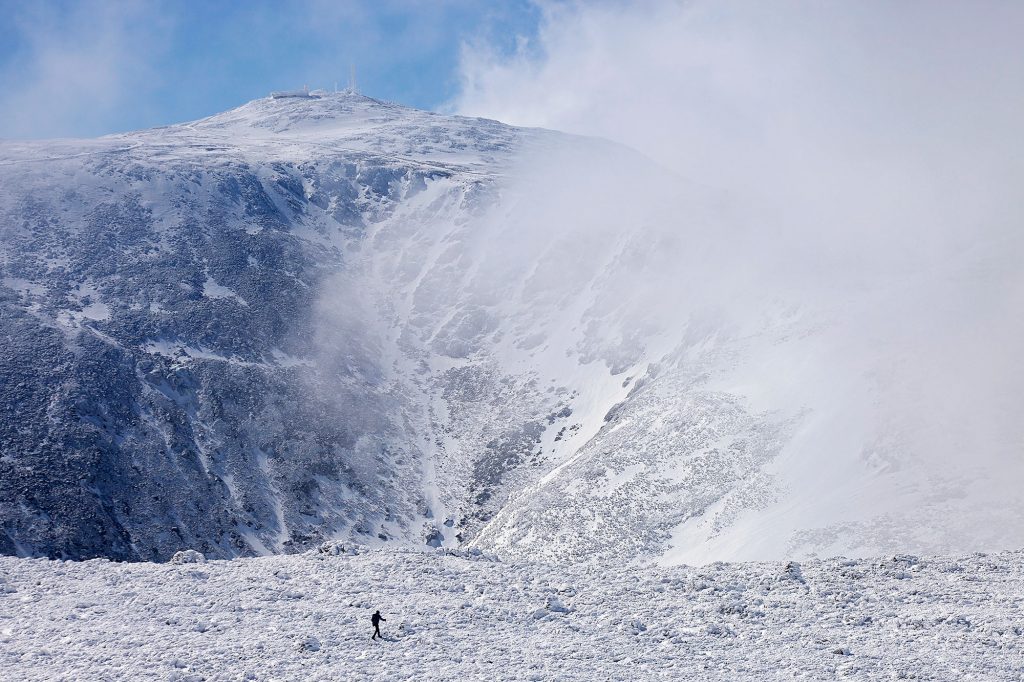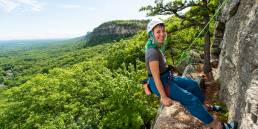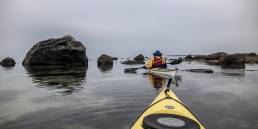If you’ve ever picked up a guidebook and thought about hiking every trail contained within it, you—surprisingly—wouldn’t be alone. Philip Carcia’s energy for hiking is limitless, which is exactly why that’s what he did with the AMC’s White Mountain Guide. When you understand a little about what compels Philip Carcia to lace up his hikers every day, you’ll know why his nickname of “Finding Philip” is apt. The mountains are his daily bread, his inspiration, and his fuel for endless hiking. We sat down with him to talk a little bit about what drives him to take on such massive objectives.

goEast: How old are you?
PC: 38.
goEast: What was your first hiking experience?
PC: Mount Wachusett when I was about 16. It was an incredible transformative experience, getting on the trail, going to the summit, and looking back on the city. I immediately went home and started searching for information and reading about the White Mountains.
goEast: When did you start hiking seriously in the Whites?
PC: I did my first 48 (New Hampshire’s 4,000 foot mountains) in 2015. I did my first single year grid in 2018.
goEast: Have you done other significant hiking projects?
PC: Yes, for about 10 or 15 years I had the good fortune to take on several iconic long distance trails, like the AT and the Pacific Crest Trail. It became a lifestyle for me. I was only working to take time off to pursue these goals. I stopped in 2014 when my father was diagnosed with lung cancer and died. I wanted to be able to be with him every day. It was the scariest thing I’d ever seen, and yet it was life re-affirming. I began living directly from my heart.
goEast: How many miles do you hike a year, on average?
PC: Between 2,500 and 3,000. I ascend between 700,000 and a million feet of vertical gain.
goEast: How many calories do you consume when you’re pursuing a goal like the White Mountains grid (hiking all 48 of the 4,000 foot mountains every month for a year)?
PC: Between 6,000 and 8,000 calories a day.
goEast: That many miles must take a toll on your footwear. How many pairs of trail shoes do you go through in a year?
PC: Three to four but that’s pushing the limits of the material, wearing them for 700 or 800 miles.
goEast: Describe the psychological part of hiking.
PC: I’m always testing my limits, constantly rewiring what I see as my potential. Hiking is an opportunity for personal growth. I’ve danced with my own potential as an outdoor athlete. When thinking about behemoth projects I know there’s more to give, that there’s more output available. It’s scary to think about that kind of output. The wattage is available but you might get shocked when the time is right.
goEast: You were the first to hike the entirety of the White Mountains Guide in single season. How long did that take?
PC: Three years. It was 90 or so days of solid hiking, about 21.7 miles and 6,600 vertical feet a day. I fell short the first two years. But if you tap into your own accountability, diligence, and respect for the project you’re working on and eliminate distractions you can dial it in.

goEast: What did you change about your approach after not hitting your goal?
PC: I wasn’t eating when I wasn’t hungry, and you really need to be eating all day long during an intense multi-week project like that. People ask if I eat clean, and I do as much as possible, but to consume that many calories requires things like burgers, pizza, and snickers.
goEast: What was it like to finish the Guide in 2022 after working so hard and not making the cutoff twice?
PC: There’s a photo of me sitting on the driveway of the lodge at Moosilauke, just dazed and probably crying. The Guide felt like it was right on the edge of what I could pull off. This winter I’m really glad I’m not getting ready for a fourth attempt.
goEast: Are you ready for the “what’s next” questions?
PC: I’m always interested in taking on pioneership, which are single or multi-day projects that will hopefully inspire other people. I have two projects in mind which will require an intimidatingly large amount of money or a sponsorship. The first is a New England 67 highest single-year grid. But more likely is the first White Mountain grid and guidebook in a single calendar year. It’s a behemoth project to think about completing both in a calendar year. It’s scary and crazy to think about. It would be about 1.6 million feet of climbing and an excess of 5,000 miles of hiking. It’s one of the only remaining truly behemoth projects left in the White Mountains National Forest. This is what’s keeping me awake at night, the idea of combining these two projects has consumed me for the last four years.
goEast: Your artistic interpretation of the mountains in photos and videos is important to you, isn’t it?
PC: Yes, I cannot imagine being out there and not documenting the experience. When I was 13 years old I got my first camcorder. I shoot hours of video and curate it. I balance taking photos with being present but the creativity sometimes takes over.
goEast: What are you doing this winter?
PC: I work at the Notch Hostel in Woodstock. I’m still inclined to hike every day to stay in shape as well as to document and share those experiences, to show people how lucky we are to get a chance to go out and do this stuff.
goEast: What will you do long term? Do you see yourself guiding others?
PC: I would give up all the checks on all of the lists I have to exchange them for the golden ticket, which is some assurance that I’ll still be doing stuff like this at 60 or 70, getting up peaks with folks half my age. I love the idea of building community, of sharing my experiences and having that be some form of education for others.
Alison O'Leary
Alison O’Leary is an avid cross country skier, author, and public speaker. See alisonoleary.com.
Related Posts
April 24, 2024
What to Bring When Road Tripping with Your Dog
Prepare for the ultimate road trip with…




